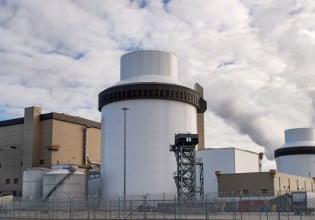High-Voltage Recovery Diodes Targeted for EV Onboard Chargers
Nexperia has announced new 650-volt recovery diodes in compact CFP packaging for electric vehicle onboard chargers, solar inverters, and power supplies.
Nexperia has expanded its portfolio of Clip-bonded FlatPower (CFP) packaged ultrafast recovery diodes for industrial and automotive applications. Four new models are being released with extended ratings to 650 volts and 1 ampere, available in both CFP3 and CFP5 packages.
Two of the four variants (PNU65010ER-Q, CFP3, and PNU65010EP-Q, CFP5) are AEC-Q101 automotive-qualified for use in applications such as electric vehicle (EV) onboard chargers (OBS) and traction inverters, while the industrial models (PNU65010ER, CFP3, and PNU65010EP, CFP5) are well-suited to power converters, solar photovoltaic inverters, and power supplies.

New 650-volt recovery rectifiers for automotive and industrial applications. Image used courtesy of Nexperia
Electric Vehicle Onboard Charger (OBC) Application
The onboard charger (OBC) in an EV converts single- or multi-phase AC power from Level 1 and 2 chargers into DC voltages up to 400 volts or higher, for charging the powertrain lithium-ion (Li-ion) battery packs. The OBC circuit first converts AC power from the Level 1 or 2 charger to DC. A transformer-isolated DC-DC converter, in coordination with the EV battery management system (BMS), then converts this intermediate DC bus voltage to the desired DC level for charging the batteries.

EV onboard charger (OBC) application circuit. Image used courtesy of Nexperia
Active switching based on MCU control logic with high-voltage field-effect transistors, or FETs (SiC, IGBT, GaN), are typically used for bridge rectification and inverter functions to maximize efficiency and performance. However, for the more common unidirectional OBC topologies, where power flows only to the EV battery from the charger, diodes will be used by system designers on the secondary side. Still, these diodes need to have good switching performance to optimize efficiency and a reverse voltage (VR) rating of up to 650 volts to be able to withstand the voltage levels of the powertrain battery pack.

Rectifier diodes replace FETs on secondary for unidirectional OBC circuits. Image used courtesy of Nexperia
Higher Voltage New for Clip-Bonded FlatPower Packaging
The copper CFP packaging is based on technology developed for Nexperia’s metal-oxide-semiconductor field-effect transistors (MOSFETs), but was never rated to more than 200 volts.
Dr. Dirk Wittorf, senior director of corporate development, strategy, and mergers and acquisitions (M&A) for Nexperia, told EE Power in an exclusive interview, “We developed this [CFP packaging] several years ago, but what is new for us is 650 V”.
The higher-voltage capability expands the range of potential applications for the company’s diodes.
"One of the directions for us is high-power, [up to] 650 volts. We see two main applications that we are going to target: one is on-board charging, and the other is photovoltaic," Wittorf added.
The small CFP footprint saves space compared with similar surface-mount (SMA/B) package options, allowing for a higher-density design.

CFP packaging construction, dimensions, and thermal performance. Image used courtesy of Nexperia
Diodes Enhance Recovery Time, Improving System Efficiency
The new ultrafast recovery diodes offer an optimal trade-off between recovery time and forward voltage drop, minimizing power losses in high-frequency applications like EV, solar, and power inverters. In these circuits, the bridge diodes must quickly transition between forward and reverse bias states to reduce power losses, so recovery time is an important specification to meet conversion efficiency targets. For an EV, this translates to more range between charges and faster charging times.
Reverse recovery time (tRR) is roughly the amount of time it takes for the diode to recover from a reverse bias to a nominal forward bias operating condition. For a slope recovery, with the forward current (IF) declining into the reverse bias region at a rate of 50A/µs to the peak reverse recovery current (IRM) threshold, the typical recovery time is 39 nanoseconds (ns).

Reverse recovery definition, ramp recovery. Image used courtesy of Nexperia
Nexperia Invests Further in Recovery Rectifier Variants
Recognizing growing demand across industries, Nexperia is investing aggressively in further expansion of its recovery rectifiers to include variants up to 30 amps of rated current at 650 volts. Models with ratings up to 2 and 3 amps in CFP packaging are slated for release in the first quarter of 2023, with releases in DPAK/D2PAK targeted for later in 2023 and into 2024.

At Electronica, Dale Wilson, left, EEPower’s director of engineering & content, talks with Nexperia’s Dr. Dirk Wittorf, senior director of corporate development, strategy, and mergers and acquisitions. Image used courtesy of EETech
According to Wittorf, the pace of innovation has really picked up in the past five to 10 years, particularly in the automotive space. It just keeps getting “faster and faster,” he said.
“The EV market is increasingly competitive, and I think we will continue to see interest in higher-performance power conversion components,” Wittorf said. “Better-performing components are a good investment for EV OEMs who need to squeeze out every bit of power conversion efficiency to extend vehicle ranges; improve charging times; and reduce the size, weight, and cost of powertrain battery packs.






